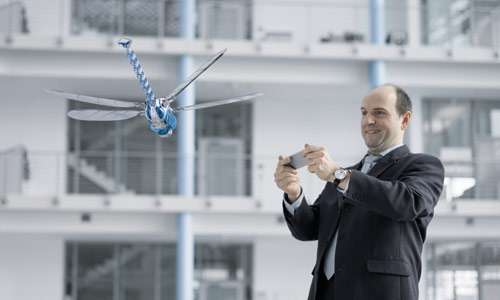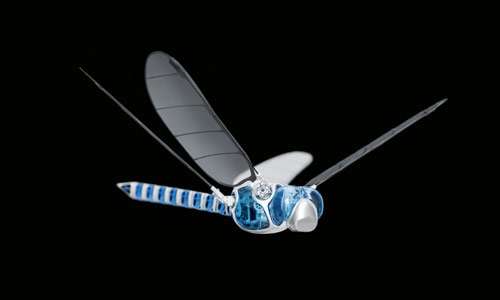April 1, 2013 report
Festo builds BionicOpter—fully functional robot dragonfly (w/ Video)

(Phys.org) —German technology company Festo has unveiled the BionicOpter, a fully functional robotic dragonfly. It can fly forwards, backwards, hover and even fly sideways—just like a real dragonfly. Its introduction marks another step forward in robotics engineering.
The BionicOpter isn't as tiny as its natural counterpart—it's approximately 19 inches long with a wingspan of just over 27 inches. But it looks a lot like the real thing with its dual pair of wings operating independently affixed to its rail thin body and slightly bulbous light blue head. It weighs, remarkably, just 175gms.
Festo hasn't yet demoed the BionicOpter to a live audience just yet—thus far pictures and video posted on the company's site are the only evidence of its existence. But all that is to change as the company will be giving a demonstration of their new robotic insect at the upcoming Hannover Messe technology fair in Germany.
Festo claims it has mastered the technically complex process involved in dragonfly flight. That's no small boast. The dragonfly is a master flyer—it can hover, fly backwards, even glide with no wing movement at all. Robots that can mimic such flight would have more capabilities than planes or helicopters, or even quadcopters (they can't glide when turned off). That it is able to do so with all of its "brains" (and a battery) tucked inside such a tiny little frame is truly remarkable. Its wings—made of foil and carbon-fiber—are moved by individual tiny servo-motors that allow for 90 degrees of adjustment—all controlled by a single ARM microprocessor. They can generate thrust in all directions. Flight is controlled by adjusting for wing flapping speed, amplitude and twist. The BionicOpter has 13 degrees of freedom—9 from the wings and 4 from head and tail movement.

The company hasn't divulged any planned use for such a flying robot—as it presently exists, it appears it's little more than a display of technical brilliance—but, it's not difficult to see how others might tweak the design a little bit to add functionality. Adding a stinger for example, or a camera, or more menacingly, explosives or hazardous chemicals to create a very lethal weapon might not be out of the realm of possibility. More optimistically, the design appears to open the door to the opportunity of a new form of human flight—if the robot were to be made bigger, rather than smaller—perhaps it could carry a person inside.
More information: www.festo.com/cms/en_corp/13165.htm
© 2013 Phys.org



















